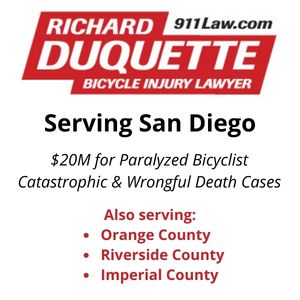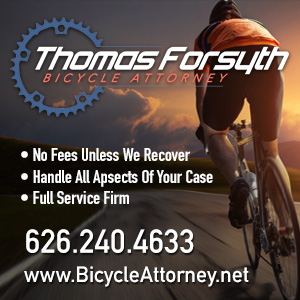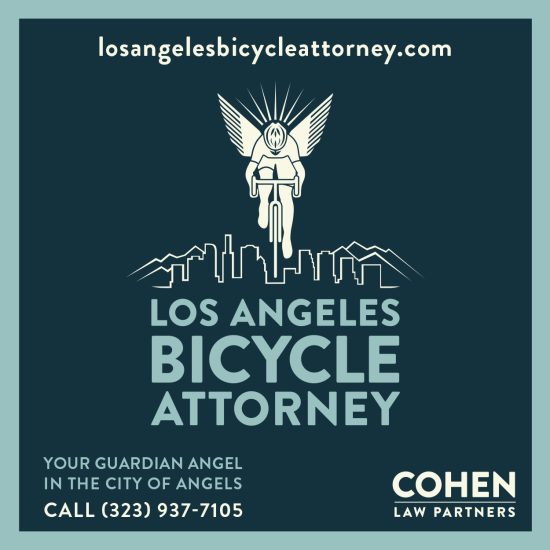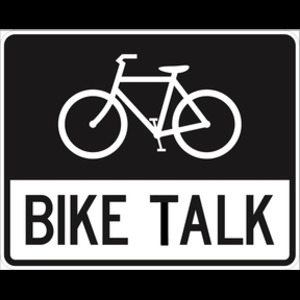
New US Census estimates show fewer people are commuting by bicycle than in years past, while Los Angeles is stuck at a 0.9% bike mode share.
However, Census Bureau estimates have always been problematic, since they only include people who actually ride to to a job.
People who commute to school or other destinations aren’t counted in the census, and people who live in immigrant or lower income neighborhoods tend to be undercounted.
………
As if terrestrial drivers weren’t bad enough, now we have to worry about flying cars and their power lines.
Which brings up the question of whether the three-foot passing law applies to overhead, as well.
………
Local
LADOT summarizes the recent street improvement workshop for Winnetka Ave.
The LA Times reports that Bird has pockmarked Los Angeles with individual no fly zones where e-scooters are discouraged, if not prohibited.
CiclaValley discovers nice, smooth new pavement in Griffith Park.
State
San Diego police are looking for a pair of bat-wielding bike riders who attacked a man sitting on a bus bench, striking him in the head with a baseball bat before escaping on their bikes.
The San Diego Association of Governments, aka SANDAG, has hired Hasan Ikhrata to be its next executive director; he’s leaving his post as head of the Southern California Association of Governments, aka SCAG, after ten years.
San Jose drivers can’t seem to figure to the city’s new parking protected bike lane.
A Bay Area writer discusses his decision to go carfree ten years ago, with no regrets.
Sad news from San Francisco, where a bike rider was killed in a collision, just blocks from where advocates had formed a people-protected bike lane to call for safer streets. Note to drivers: No bike rider has ever “come out of nowhere.”
The US Bicycling Hall of Fame in Davis will induct four new members this year, including Jennie Reed (Modern Road & Track Competitor), Eric Rupe (Off-Road Competitor), Jerry Ash (Veteran Road & Track Competitor), and Richard DeGarmo (Contributor to the Sport).
National
NPR looks at the problem of counterfeit goods — in this case, fake Specialized bike helmets.
Utah bicyclists are warning that a new road design actually forces drivers into a bike lane.
This is how it should work. Two years after Denver installed a two-way bike lane along a busy roadway, it’s proven successful enough to expand to remove a lane of traffic to expand it another 1.5 miles along the street.
No bias here. A Wisconsin letter writer says streets are for cars, and drivers shouldn’t be impeded by bicyclists, joggers and dog walkers, because drivers are going places to do important things, while bike riders are “going nowhere, to do nothing.”
Chicago Cubs player Ben Zobrist is one of us, riding to Sunday’s game at Wrigley Field on his upright bike — wearing his uniform. So who says you have to wear special clothes to bike commute?
A 23-year old Michigan woman was arrested for fleeing the scene after killing a bike rider on Saturday; she still had a BAC three times the legal limit hours after the crash. Her lawyer will undoubtedly argue that she only got drunk after the crash because she was so freaked out.
He gets it. Writing for the American Conservative, an Akron, Ohio planner looks at the problem of Baby Boomers aging in a car-dependent world. Although one solution would be to install protected bike lanes that would allow seniors to bike safely and conveniently, while improving their health.
People in Indianapolis IN are making a difference in the community by opening a bike shop. Although it sounds more like a bike co-op.
The Burrito Riders of Louisville takes to their bikes twice a month to feed the homeless in the Kentucky city.
The war on cars may be a myth, but the war on bikes goes on. Someone has sabotaged a Massachusetts bike path with hundreds of thumb tacks.
A New York bike lawyer calls for a speed limit in bike lanes to combat speeding scooter riders.
A South Carolina letter writer makes the point that building bike lanes isn’t enough, cities have to maintain them, as well.
International
City Lab talks with Vancouver’s Melissa and Chris Bruntlett, authors of Building the Cycling City: The Dutch Blueprint for Urban Vitality, who say bicycling is the key to healthier and more vibrant cities.
Road.cc offers money saving tips ranging from learning how to patch a tube to when to buy bikes and parts on sale. Unfortunately, we can’t use the first tip; British commuters can deduct 25% of the cost of a new bike and accessories, but the only small tax benefit for US bike commuters was lost in the recent tax reforms.
Nearing the end of a round-the-world bike tour, a woman sets off through Mexico on a search for a lost British Surrealist.
A group of Canadian mounties have set off on a ten-day, 621-mile ride to raise funds for kids.
A Canadian writer says he’s become completely and utterly addicted to bike commuting. Even after crashing into an illegally parked car.
A London letter-writer says bicyclists should be forced to wear license plates on their bike helmets. Sure. What could possibly go wrong with that? And what’s with the bizarre, yet common belief that police will track down scofflaw bike riders, when they don’t do that with drivers?
British drivers will now be required to give bike riders a nearly five foot passing distance, or pay the equivalent of a $130 fine.
No bias here. London’s Daily Mail says last week’s death of a pedestrian at the hands of an ebike rider could be just the first of many, calling ebikes “the silent killer on our streets.” Never mind that ebikes in the UK are limited to 15.5 mph, which is slower than the cruising speed of many non-powered road bike riders. Or that it’s entirely possible the rider wasn’t at fault.
They get it. France plans to triple the rate of transportation bicycling in time for the 2024 Paris Olympics through better bike infrastructure, financial incentives, and taking steps to fight bike theft.
A Delhi writer describes the daily humiliation faced by bike riders on the city’s streets, where they’re considered trespassers by drivers.
Tuesday marks the holiest day on the Jewish calendar. It’s also a day many Israelis take to their bikes on streets empty of vehicular traffic.
Caught on video: After Emirates police post video of a speeding driver hitting a bike rider after cutting across several lanes of freeway traffic, the press blames the guy on the bike for just being there.
Police in the UAE have permanently seized 435 bicycles and motorcycles in a crackdown on scofflaw riders for violating basic traffic laws, as well as failing to wear helmets or hi-viz. Which is fine, as long as they also seize cars, trucks and SUV for the same violations.
We already knew Patrick Dempsey was one of us, as he discusses his life in front of the camera and on two wheels with a Kiwi news site.
A Canadian tourist goes bike riding in the land of Mickey Mao.
Competitive Cycling
Great Britain stakes its cycling supremacy with Simon Yates’ victory in the Vuelta; the country swept all three Grand Tours, thanks to Geraint Thomas’ Tour de France win and Chris Froome’s victory in the Giro.
Pro cyclist and gravel racing champ Allison Tetrick walked away from a career in molecular biology to compete on her bike.
Great story from Bicycling about Jim Nelson, who won an age group BMX national championship just days after his last chemo treatment for stage three non-Hodgkin’s lymphoma.
Two cyclists were disqualified at the end of a 206-mile race through Utah and Wyoming for taking selfies at the finish line; a third was DQ’d for flipping it off.
There’s a new women’s hour record, courtesy of Italian rider Vittoria Bussi.
Denise Mueller-Korenek is now the fastest woman — no, make that human — on earth, after setting a new record for a human-powered vehicle at 183.93 mph, beating the old record by over 16 mph.
Finally…
It takes a rare candidate to unite weed users, bike riders and sex workers against her. Get that healthy nuclear glow on your next ride.
And don’t take someone else’s parking space in Texas.
………
Thanks to John H and Tom S for their generous donations to help keep this site coming your way every day.
If everyone who visits BikinginLA today donated just $10, it would be more than enough to keep to keep this site going for a full year.
………
Join the Militant Angeleno and BikinginLA for the first-ever Militant Angeleno’s Epic CicLAvia Tour at the Celebrate LA! LA Phil 100 CicLAvia on September 30th!
Just RSVP to MilitantAngeleno@gmail.com. We want to guarantee a relatively small group to make sure we can keep the group together, and everyone can hear.


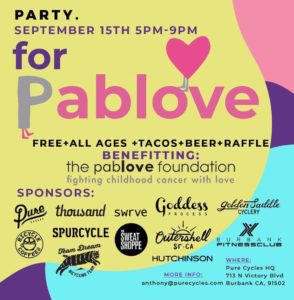 Also tomorrow, BikeSGV and Metro BEST are holding the
Also tomorrow, BikeSGV and Metro BEST are holding the  Beverly Hills is hosting the formal dedication and ribbon cutting for the reconstructed Santa Monica Blvd at 1:30 pm this Monday, including the new green bike lanes. Maybe it’s also time to formally retire their designation as the former Biking Black Hole of Beverly Hills.
Beverly Hills is hosting the formal dedication and ribbon cutting for the reconstructed Santa Monica Blvd at 1:30 pm this Monday, including the new green bike lanes. Maybe it’s also time to formally retire their designation as the former Biking Black Hole of Beverly Hills.
 He also notes that on just the second day of his ride, a total stranger insisted on giving him $20 to buy lunch.
He also notes that on just the second day of his ride, a total stranger insisted on giving him $20 to buy lunch.












